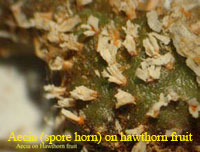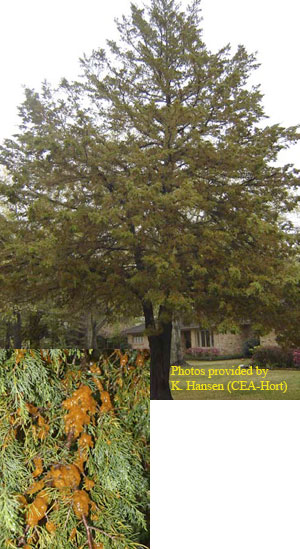Extension Plant Pathology
https://plantclinic.tamu.edu
Download PDF
PLPA-113
In Texas, there are several different rust diseases that can affect trees and woody ornamentals. Among these, cedar-quince rust is the most damaging to rosaceous plants such as quince, pears, hawthorn and crabapples. Although cedar-apple rust and cedarquince rust fungi are from the same genus (Gymnosporangium) and have many similarities, they do exhibit some differences such as gall shapes on the junipers and the primary infected tissue on
they do exhibit some differences such as gall shapes on the junipers and the primary infected tissue on
rosaceous hosts.
CAUSAL AGENT and
DISEASE CYCLE
Cedar-quince rust is caused by a fungal pathogen, Gymnosporangium claviceps.
This fungus must spend a part of its life cycle on junipers, particularly Eastern red cedars. It alternates between junipers and a wide range of rosaceous host. The galls produced on juniper have an elongated swollen appearance and are less obvious than cedarapple rust galls until the teliospores are produced in the yelloworange “goop”  (telium). These galls on the junipers are capable of producing telia for several years. Infected twigs often die. The teliospore infects the alternate host, resulting in spots on fruit and twig (less often on leaves) on the rosaceous host. Later in the season fruit may be covered in orange-reddish spore horns, which will release spores to reinfect the junipers.
(telium). These galls on the junipers are capable of producing telia for several years. Infected twigs often die. The teliospore infects the alternate host, resulting in spots on fruit and twig (less often on leaves) on the rosaceous host. Later in the season fruit may be covered in orange-reddish spore horns, which will release spores to reinfect the junipers.
MANAGEMENT
- Grow resistant varieties trees i.e. Juniperus virginiana (E. red cedar) varieties ‘Aurea’, ‘Globosa’, ‘Pyramidalis’, ‘ Tripartita’.
- Remove and destroy galls on cedar. Unlike the cedar-apple rust, this task is more difficult because of the less obvious shape and appearance of the gall.
- Remove a host to break the disease cycle. This strategy may not always work due to the ability of the spore to be
dispersed over long distances. It is not recommended to plant junipers adjacent to rosaceous host. - Fungicides may be used on rosaceous hosts in the spring to protect it when spores are disseminated from the juniper host (when the yellow ‘goop’ appears on the junipers and are starting to dry). Fungicides containing the following active ingredients (common brand name) are commonly used to manage this disease: Mancozeb, Chlorothalonil (Daconil), Myclobutanil (Immunox), Tridiamefon (Bayleton), and Propiconazole (Banner). It is the user’s responsibility to follow fungicide label directions.
Additional assistance can be obtained for your local AgriLife Extension county office.
Prepared by Dr. Kevin Ong (Director – TX Plant Disease Diagnostic Lab)
Associate Professor and Extension Plant Pathologist
Texas AgriLife Extension Service; The Texas A&M University System
March 19, 2009
